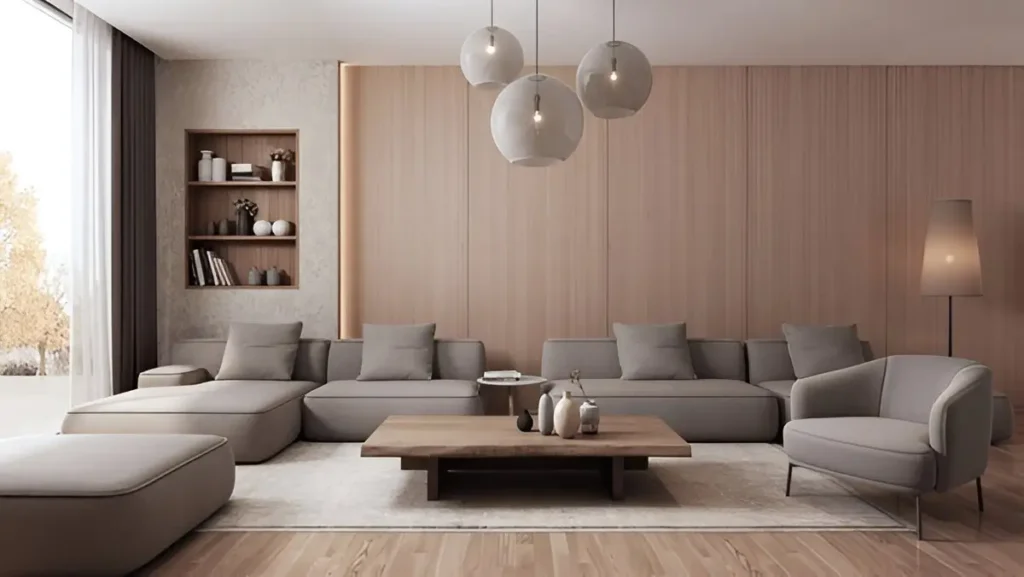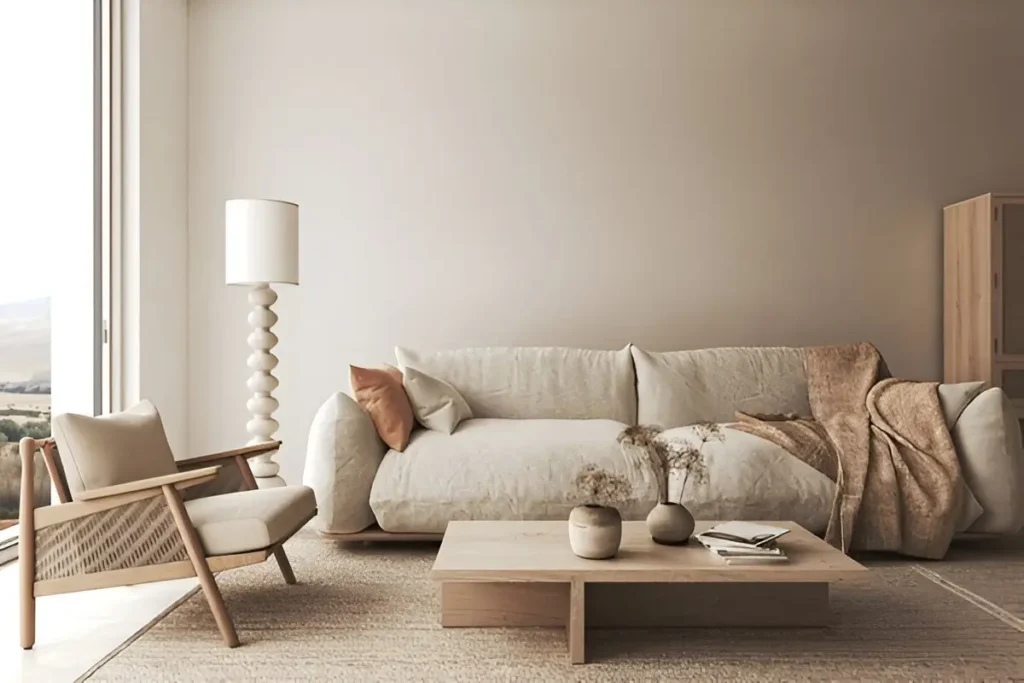7 Key Elements of Japanese Living Room Design You Need to Know
January 25, 2025 | by hiliga24


Japanese living room design has surged in popularity, with Pinterest reporting a 135% increase in searches for this style. As people seek mindfulness and tranquility in their homes, the Zen principles and calming elements of Japanese design have become a go-to inspiration. This article explores the key elements of Japanese living room design and offers practical tips on how to incorporate this timeless aesthetic into your own space.
Key Elements of Japanese Living Room Design: Nature, Simplicity, and Tranquility
Japanese living room design is rooted in a deep connection to nature, simplicity, and tranquility. These principles create spaces that feel serene, balanced, and harmonious. Let’s break down the essential elements that define this style.
How Japanese Living Room Design Blurs the Line Between Indoors and Outdoors
One of the hallmarks of Japanese living room design is its seamless integration of nature into the living space. Traditional Japanese homes often feature central courtyards, sliding glass walls, or large patios that blur the line between indoors and outdoors.
“Traditional Japanese homes often feature a central courtyard, blurring the line between indoors and outdoors,” says Yoko Oda, a San Francisco-based designer. “This connection to nature is a cornerstone of Japanese design.”
Even if your living room doesn’t have direct access to outdoor spaces, you can still capture this essence. Incorporate potted plants, bamboo arrangements, or a small indoor water feature to evoke the feeling of nature.
The Role of Clean Lines and Minimalism in Japanese Living Room Design
Clean lines and a minimalist approach are central to Japanese living room design. Historically, Japanese homes featured sparse furniture, with people sitting directly on Tatami mats. This created open, uncluttered spaces that promoted a sense of calm.
“Japanese living rooms are characterized by clean lines and a minimalist approach,” says Oda. “Start by simplifying your space—remove unnecessary furniture and focus on functionality.”
To achieve this look, opt for built-in cabinets, low-profile furniture, and neutral colors. Avoid oversized furniture, which can disrupt the balance and flow of the room.
Natural Materials and Earth Tones: Essential to Japanese Aesthetics
Natural materials and earthy color palettes are foundational to Japanese living room design. Materials like wood, bamboo, and Tatami mats bring warmth and texture to the space, while neutral tones like beige, white, and soft browns create a calming atmosphere.
“The color palette is typically composed of quiet, neutral earth tones, enhancing the connection to nature,” says Oda. She recommends light-colored hardwood flooring and floating Tatami mats as rugs to anchor the design.
Jarret Yoshida, a Brooklyn-based designer, emphasizes the importance of natural textures. “Incorporate materials like stone, rope, and hemp, which are commonly found in Shinto shrines,” he says. “These elements add authenticity and depth to the design.”
How to Incorporate Japanese Living Room Design Principles into Your Home
Embracing Japanese living room design doesn’t mean replicating traditional Japanese homes exactly. Instead, it’s about interpreting the ethos behind the style and adapting it to your space. Here’s how you can bring this aesthetic into your home.
Declutter Your Space: The First Step to Japanese Living Room Design
Clutter is the enemy of tranquility. To create a Japanese-inspired living room, start by decluttering your space. Remove unnecessary items and focus on keeping only what serves a purpose or holds meaning.
“A living room that pulls in elements of Japanese design should be calm,” says Yoshida. “It’s not filled with tchotchkes; you’re not just buying art to fill a wall.”
Adopt a minimalist mindset and prioritize intentional decor. This approach aligns with the Japanese concept of ma, or negative space, which emphasizes the beauty of emptiness.
Bring Nature Indoors: Plants and Natural Elements in Japanese Design
Nature is a central theme in Japanese living room design. Even if you don’t have a garden or patio, you can bring the outdoors in with plants, natural materials, and organic textures.
“Even a small plant arrangement can capture the essence of nature,” says Oda. Consider adding bonsai trees, bamboo stalks, or a simple vase with seasonal flowers to your living room.
Yoshida also recommends incorporating natural textures like stone or wood. “Not man-made textures, like slick marble, but something raw and authentic,” he says. “A beautiful piece of slate or Yakisugi—burnt wood—can add character to the space.”
Traditional Touches: Shoji Screens and Tokonoma in Modern Japanese Living Rooms
While traditional elements like Shoji screens and Tokonoma (decorative alcoves) are iconic in Japanese design, they don’t have to be used literally. Instead, find modern interpretations that evoke the same feeling.
“Please do not put a Japanese Shoji screen into your house—that’s so 1980,” says Yoshida. “It’s not about being literal; it’s about interpreting the vision behind them.”
For example, use bamboo blinds or paper lanterns to mimic the soft, diffused light of Shoji screens. For a Tokonoma-inspired display, dedicate a small shelf or alcove to a seasonal arrangement, such as a vase with fresh flowers or a piece of art.
Tips for Embracing Japanese Style in Your Living Room
Japanese living room design is driven by intention and mindfulness. Here are some additional tips to help you create a space that reflects this aesthetic while staying true to your personal style.
Avoid Bold Statements
In Japanese design, subtlety reigns supreme. Avoid bold, attention-grabbing elements and instead focus on creating a cohesive, understated look.
“We tend to bring in something that’s really bold and stands out in a space, but that’s a no-no in Japanese design,” says Oda. “It’s more about evoking emotions in a very subtle way.”
Keep Color and Pattern Minimal
While Japanese design is often associated with neutral tones, color and pattern can still play a role—just in moderation.
“Color does exist in Japanese design, and it’s very important,” says Yoshida. “But it’s used sparingly, like in floral arrangements or decorative pillows.”
Prioritize Reuse and Authenticity
Sustainability is a key principle of Japanese living room design. Instead of buying new, opt for vintage or antique pieces that have a story to tell.
“Get something antique over 100 years old, get something vintage. Don’t get something new,” says Yoshida. “Be interested in patina. Be interested in age.”

Why is Japanese furniture so low
Japanese furniture is traditionally low to the ground due to a combination of cultural, historical, and practical reasons. This design philosophy is deeply rooted in Japanese lifestyle, architecture, and aesthetics. Here are the key reasons why Japanese furniture is so low:
- Cultural and Historical Influences
Tatami Flooring: Traditional Japanese homes feature Tatami mats, which are made of woven straw and provide a soft, natural surface for sitting and sleeping. Low furniture complements these mats and avoids damaging them.
Sitting on the Floor: In Japanese culture, sitting directly on the floor (on cushions or Tatami mats) is a common practice. This stems from the use of zabuton (floor cushions) and chabudai (low tables) for dining, tea ceremonies, and social gatherings.
Minimalist Lifestyle: Japanese design emphasizes simplicity and minimalism. Low furniture helps maintain an open, uncluttered space, aligning with the Zen principles of mindfulness and tranquility.
- Architectural Considerations
Low Ceilings: Traditional Japanese homes often have lower ceilings compared to Western architecture. Low furniture creates a sense of proportion and harmony within these spaces.
Sliding Doors (Fusuma and Shoji): Japanese rooms are typically designed with sliding doors and partitions, which allow for flexible use of space. Low furniture ensures these doors can open and close without obstruction.
- Practicality and Flexibility
Multi-Functional Spaces: Japanese homes often have rooms that serve multiple purposes (e.g., a living room by day and a bedroom by night). Low furniture, such as futons (foldable mattresses), can be easily moved or stored to adapt to different needs.
Ease of Movement: Low furniture makes it easier to move around in small spaces, which is especially important in compact Japanese homes.
Connection to Nature: Japanese design often blurs the line between indoors and outdoors. Low furniture enhances the view of the surrounding environment, whether it’s a garden, courtyard, or natural landscape.
- Health and Comfort
Ergonomics: Sitting close to the ground can promote better posture and flexibility. Traditional Japanese seating, such as seiza (kneeling), encourages core strength and alignment.
Relaxation: Low furniture, like floor cushions and futons, creates a cozy and relaxed atmosphere, perfect for unwinding after a long day.
- Aesthetic Appeal
Harmony and Balance: Low furniture contributes to the overall aesthetic of Japanese interiors, which prioritize balance, proportion, and simplicity. It creates a sense of calm and order in the space.
Focus on Horizontal Lines: Japanese design often emphasizes horizontal lines, which evoke a sense of stability and tranquility. Low furniture reinforces this design principle.
- Modern Adaptations
While traditional Japanese furniture remains low, modern designs have adapted to contemporary lifestyles. For example:
Western Influence: Many Japanese homes now incorporate Western-style furniture, such as sofas and beds, but often in lower profiles to maintain a connection to traditional aesthetics.
Hybrid Styles: The popularity of Japandi (a blend of Japanese and Scandinavian design) has introduced low furniture with clean lines and minimalist forms to global audiences.
Japanese Living Room Design Is Trending On Pinterest
Japanese living room design is currently trending on Pinterest. According to the Pinterest Fall 2024 Trend Report, searches for “Japanese living room design” increased by more than 130%, reflecting a growing interest in this style. The trend aligns with the broader popularity of Zen principles, minimalism, and nature-inspired interiors, which are central to Japanese design.
Pinterest attributes this surge in interest to several factors:
- Mindfulness and Tranquility: People are seeking calming and serene spaces in their homes, and Japanese design offers a perfect blend of simplicity and tranquility.
- Influence of Japanese Culture: The influx of travelers to Japan, combined with the lower value of the yen, has made Japanese culture and design more accessible and appealing.
- Overlap with Popular Styles: Japanese living room design shares similarities with other trending aesthetics like Japandi (a fusion of Japanese and Scandinavian design) and organic modern styles, making it a natural choice for many homeowners.
The trend highlights the timeless appeal of Japanese design principles, such as clean lines, natural materials, and a connection to nature, which resonate with modern audiences looking to create peaceful and intentional living spaces.
Conclusion
Japanese living room design offers a timeless aesthetic that promotes mindfulness, tranquility, and a deep connection to nature. By incorporating clean lines, natural materials, and intentional decor, you can create a space that feels both serene and sophisticated. Whether you’re drawn to the minimalist principles of Japandi or the organic warmth of traditional Japanese design, this style is adaptable to modern homes.
As you embark on your design journey, remember that Japanese living room design is not about perfection—it’s about embracing the essence of simplicity, authenticity, and harmony. With these principles in mind, you can transform your living room into a peaceful sanctuary that reflects the beauty of Japanese culture.
RELATED POSTS
View all


